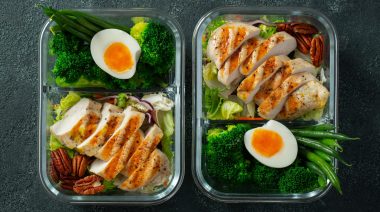You may think you’re an expert, but now it’s time for an official fitness pop quiz! I am all about espousing the truth to assist you in moving forward with your goals. That is important when sifting through the overwhelming and potentially confusing training information that exists. What is truthful and useful? What is the right path to follow to achieve your goals? Do you know the answers to common questions pertaining to health and fitness? Well, you are about find out.
The following fifteen-question quiz will challenge your basic knowledge of a number of fitness-related issues: nutrition, muscle strength and power, skill training, and endurance. There are no trick questions and it is not intended to bamboozle you.
I know you’re competitive and want to do well. Answer all fifteen correctly and you are one smart cookie. Miss two to three toughies? That’s okay. You’re still on top of your game. However, don’t go zero for fifteen. If you do, I suggest you reread all Pulse Beat Fit articles from day one. That will take some time, but it will be time well spent in the pursuit of knowledge.
This is obviously an open book quiz. Try to take the quiz without Googling or sticking your nose in a textbook to secure the answer. If you answer all fifteen questions without cheating, that will be awesome. Anything above 70% (ten out of fifteen) with no peeking is still well done.
Pop Quiz Challenge:
1. Which activity burns more calories for the average 160 pound person?
A. 25 minutes of steady-state treadmill running at 5 miles per hour
B. 20 minutes of a high intensity, minimal rest strength training circuit
C. 30 minutes of walking at 2.5 miles per hour
D. A 30-minute Pilates session
2. More potential repetitions can be performed in the pull up with:
A. A narrow grip with the forearms supinated (palms facing you)
B. A wide grip with the forearms pronated (palms facing away from you)
C. A narrow grip with the forearms pronated
D. A wide grip with the forearms supinated
3. The expression of power can best be described as:
A. Force x Speed x Time x Effort
B. Speed x Force divided by Momentum
C. Distance moved divided by Speed x Volume
D. Force x Distance divided by Time
4. Which of these foods has the most calories?
A. One medium-size baked potato with a teaspoon of butter
B. A four ounce roasted chicken breast (skinless)
C. Two ounces of candy corn (approximately 32 pieces)
D. A 16oz fountain cola
5. To safely improve the development of power in your specific event, which of the following is the best option?
A. Box jumps to 30” and 36” boxes at four to six sets of six to 10 jumps each
B. Hang snatches at five sets of 5 repetitions with 50% of your 1RM
C. Demanding total-body strength training performed with safe, intense, and progressive protocols, coupled with sensible practice of your event as you will experience it in competition
D. Light resistance kettle bell swings at four sets of 10 swings, creatine supplementation, and two Pilates sessions/week
6. Which one of the following set/rep protocols maximally overloads the greatest number muscle fibers, all other factors being equal?
A. Five sets of 5 repetitions at 65% of your 1RM
B. Five sets of 10 repetitions at 60% of your 1RM
C. Three sets of maximum repetitions (to volitional muscular fatigue) at 75% of your 1RM
D. 60% of your 1RM x 10 reps, 65% x 8 reps, 70% x 6 reps, and 75% x 4 reps
7. Which one of the following situations creates more hazardous joint stress and a greater potential for injury?
A. Using a :04 concentric (up) and :08 eccentric (down) strength training exercise performance cadence
B. Three sets of 10 repetitions with 75% of 1RM on the trap bar deadlift performed with proper technique
C. Full range of motion parallel bar dips performed with a controlled movement speed
D. Power cleans performed fast with questionable form and for the purpose of completing a maximum number of repetitions within a specific period of time
8. There are a number of established principles of training. Three of them are the principles of:
A. Modification, Energy Systems, and Effort
B. Overload, Recovery/Adaptation, and Progression
C. Volume, Specificity, and Genetics
D. Aerobic, Anaerobic, and immediate ATP-PC sources
9. The Principle of Sport Specificity can best be explained by which one of the following:
A. Perform various similar skill drills and sport-skill resistance exercises to better performance
B. Practice/replicate exact practice of your event to better your performance in that specific event
C. Use plyometric and band exercises that almost replicate your event
D. Mimic the skills of your event as close as possible with various resistance-type exercises
10. The primary energy provided to fuel sport and activity participations is provided by:
A. Dietary carbohydrates
B. Dietary polyunsaturated fats
C. Daily vitamins and mineral intake
D. Protein supplementation
11. The most pure aerobic activity you can engage in is:
A. A two and a half hour soccer match
B. Running a marathon
C. Running an ultra-marathon
D. Sleeping
12. Which one of the following is not a two-jointed muscle?
A. Biceps Femoris
B. Vastus Medialis
C. Gastrocnemius
D. Biceps Brachii
13. To improve your ability to maximally complete a CrossFit competition, your best option would be a combination of:
A. Distance running, yoga, and Olympic lifting
B. Pilates, intervals, and dynamic stretching
C. Interval sprints, static stretching, and dead lifts
D. CrossFit event practice, general strength training, and high intensity interval training
14. A 30-minute high-intensity boot camp circuit can burn up to 350+ calories for a 180 pound person. Approximately how long would a 180 pound person need to run at a 10-minute per mile pace to burn 350 calories?
A. 18 minutes
B. 21 minutes
C. 24 minutes
D. 33 minutes
15. Sarcopenia is the term for:
A. Hypertrophy
B. Complete muscle contraction
C. Maximal aerobic fatigue
D. Age related muscle loss
ANSWERS
1. Which activity burns more calories for the average 160 pound person?
A. 25 minutes of steady-state treadmill running at 5 miles per hour = 256 calories
2. More potential repetitions can be performed in the pull up with:
D. A wide grip with the forearms supinated – the biceps are in their strongest position and the range of motion is shortened
3. The expression of power can best be described as:
D. Force x Distance divided by Time
4. Which of these foods has the most calories?
C. Two ounces of candy corn (approximately 32 pieces) = 207 calories
5. To safely improve the development of power in your specific event, which of the following is the best option?
C. Demanding total-body strength training performed with safe, intense, and progressive protocols, coupled with sensible practice of your event as you will experience it in competition
6. Which one of the following set/rep protocols maximally overloads the greatest number muscle fibers, all other factors being equal?
C. Three sets of maximum repetitions (to volitional muscular fatigue) at 75% of your 1RM.
7. Which one of the following situations creates more hazardous joint stress and a greater potential for injury?
D. Power cleans performed fast with questionable form and for the purpose of completing a maximum number of repetitions within a specific period of time
8. There are a number of established principles of training. Three of them are the principles of :
B. Overload, Recovery/Adaptation, and Progression
9. The Principle of Sport Specificity can best be explained by which one of the following:
B. Practice/replicate exact practice of your event to better your performance in that specific event
10. The primary energy provided to fuel sport and activity participations is provided by:
A. Dietary carbohydrates
11. The most pure aerobic activity you can engage in is:
D. Sleeping – the other examples involve anaerobic energy pathways
12. Which one of the following is not a two-jointed muscle?
B. Vastus Medialis – one of the quadriceps
13. To improve your ability to maximally complete a CrossFit competition, your best option would be a combination of:
D. CrossFit event practice, general strength training, and high intensity interval training
14. A 30-minute high-intensity boot camp circuit can burn up to 350+ calories for a 180 pound person. Approximately how long would a 180 pound person need to run at a 10-minute per mile pace to burn 350 calories?
C. 24 minutes = 346 calories
15. Sarcopenia is the term for:
A. Age related muscle loss
How did you do? Post your score and thoughts to the comments below.
Photo courtesy of Shutterstock.






